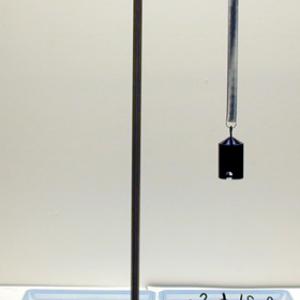College of Liberal Arts & Sciences
3A20.10 - Simple Harmonic Motion - Mass on Spring
Place the desired spring on the support and add an appropriate weight. This system can be put into motion into two ways. One way is to just pull down on a spring and release and watch it move up and down. The other way is to pull it sideways and to release it like a pendulum.
- William A. (Toby) Dittrich, "Drop Tower Physics II, TPT, Vol. 60, #7, Oct. 2022, p. 605.
- Daniel Nichols, "Measuring Mass with a Rubber Band and a Smartphone", TPT, Vol. 60, #7, Oct. 2022, p. 608.
- Nathaniel R. Greene, Tom Gill, and Stephen Eyerly, "Finding the Effective Mass and Spring Constant of a Force Probe from Simple Harmonic Motion", TPT, Vol. 54, #3, Mar. 2016, p. 138.
- Calin Galeriu, Scott Edwards, and Geoffrey Esper, "An Arduino Investigation of Simple Harmonic Motion", TPT, Vol. 52, #3, Mar. 2014, p. 157.
- Jesus Carnicer, Francisco Reyes, and Jenaro Guisasola, "How Can 'Weightless' Astronauts Be Weighed?", TPT, Vol. 50, #1, Jan. 2012, p. 12.
- Eduardo E. Rodríguez and Gabriel A. Gesnouin, "Effective Mass of an Oscillating Spring", TPT, Vol. 45, #2, Feb. 2007, p. 100.
- David E. Holzwarth and Jim Malone, "Pendulum Period Versus Hanging-Spring Period", TPT, Vol. 38, #1, Jan. 2000, p. 47.
- Clifton Bob Clark and Clifford E. Swartz, "Analytic Solution for the Oscillator with Classical Friction", TPT, Vol. 34, #9, Dec. 1996, p. 550.
- Anooshirvan Jafari, "Experimental Test of F↘=−kxnx̂", TPT, Vol. 34, #4, Apr. 1996, p. 196.
- Chris Hirata and David Thiessen, "The Period of F↘=−kxnx̂ Harmonic Motion", TPT, Vol. 33, #8, Dec. 1995, p. 562.
- W. S. Porter, "Potential Energy of a Vertical Oscillator", TPT, Vol. 31, #3, Mar. 1993, p. 175.
- R. R. Boedeker, "Vertical and Horizontal Harmonic Oscillators: An Aid to Understanding", TPT, Vol. 27, #5, May 1989, p. 378.
- Thomas D. Rossing, "Simple Vibrating Systems", TPT, Vol. 26, #1, Jan. 1988, p. 50.
- David S. Mills, "The Spring and Mass Pendulum: An Exercise in Mathematical Modeling", TPT, Vol. 19, #6, Sept. 1981, p. 404.
- Brother Eric Vogel, "Variable k for Simple Harmonic Motion Experiment", TPT, Vol. 16, #2, Feb. 1978, p. 114.
- Carl H. Hayn, "How Simple is Simple?", TPT, Vol. 10, #9, Dec. 1972, p. 488.
- Eli Maor, "A Repertoire of S. H. M.", TPT, Vol. 10, #7, Oct. 1972, p. 377.
- R. Hobart Ellis Jr., "Some Different Views of Simple Harmonic Motion", TPT, Vol. 6, #7, Oct. 1968, p. 340.
- Maurice Leclerc, "Effective Elastic Constant and Effective Mass of an Oscillating Spring: An Energy Approach", AJP, Vol. 55, #2, Feb. 1987, p. 178.
- Frederick C. Grant, "Energy Analysis of the Conical-Spring Oscillator", AJP, Vol. 54, #3, Mar. 1986, p. 227.
- Thomas E. Cayton, "The Laboratory Spring-Mass Oscillator: An Example of Parametric Instability", AJP, Vol. 45, #8, Aug. 1977, p. 723.
- Jearl Walker, "2.62. Spring Pendulum", The Flying Circus of Physics with Answers.
- W. Bolton, "31. Simple Harmonic Motion (2)", Book 1 - Properties of Materials, Physics Experiments and Projects, 1968, p. 48 - 49.
Disclaimer: These demonstrations are provided only for illustrative use by persons affiliated with The University of Iowa and only under the direction of a trained instructor or physicist. The University of Iowa is not responsible for demonstrations performed by those using their own equipment or who choose to use this reference material for their own purpose. The demonstrations included here are within the public domain and can be found in materials contained in libraries, bookstores, and through electronic sources. Performing all or any portion of any of these demonstrations, with or without revisions not depicted here entails inherent risks. These risks include, without limitation, bodily injury (and possibly death), including risks to health that may be temporary or permanent and that may exacerbate a pre-existing medical condition; and property loss or damage. Anyone performing any part of these demonstrations, even with revisions, knowingly and voluntarily assumes all risks associated with them.
